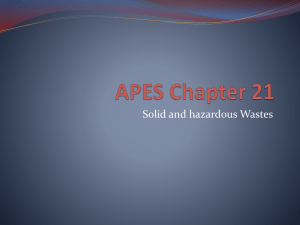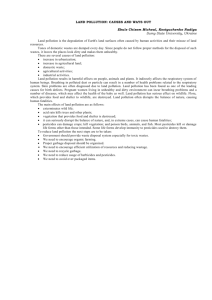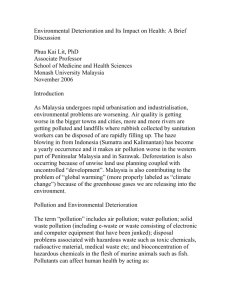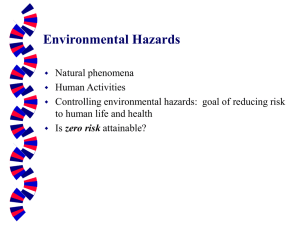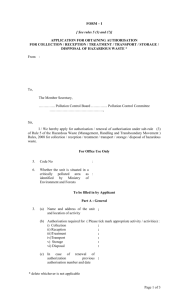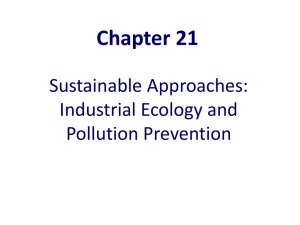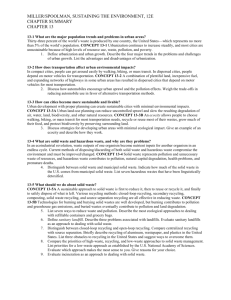Figure 1.2: Pollution Prevention Hierarchy
advertisement
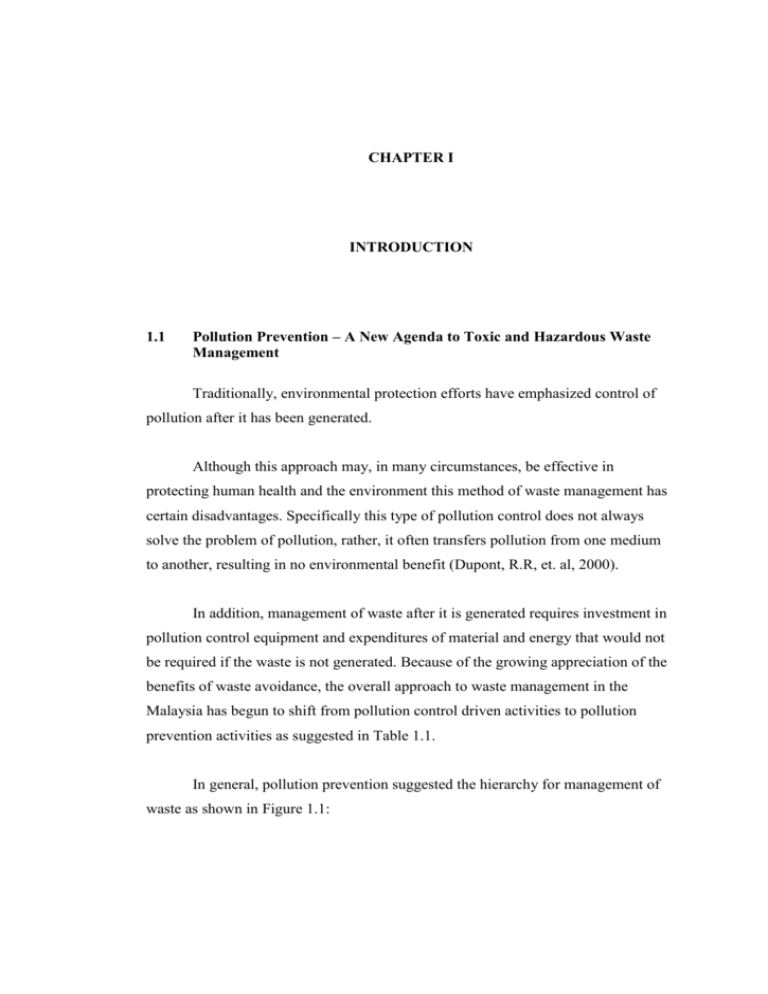
CHAPTER I INTRODUCTION 1.1 Pollution Prevention – A New Agenda to Toxic and Hazardous Waste Management Traditionally, environmental protection efforts have emphasized control of pollution after it has been generated. Although this approach may, in many circumstances, be effective in protecting human health and the environment this method of waste management has certain disadvantages. Specifically this type of pollution control does not always solve the problem of pollution, rather, it often transfers pollution from one medium to another, resulting in no environmental benefit (Dupont, R.R, et. al, 2000). In addition, management of waste after it is generated requires investment in pollution control equipment and expenditures of material and energy that would not be required if the waste is not generated. Because of the growing appreciation of the benefits of waste avoidance, the overall approach to waste management in the Malaysia has begun to shift from pollution control driven activities to pollution prevention activities as suggested in Table 1.1. In general, pollution prevention suggested the hierarchy for management of waste as shown in Figure 1.1: 2 Source reduction Recycling Treatment Disposal Table 1.1: Evolution of Waste Management Approaches in Malaysia Year Approaches Prior – 1970 No Control 1970 – 1974 Some / little control 1974 – 1980 Greater control, Environmental Quality Act came into force 1980 – 1985 More sophisticated control, Department of Environment, Malaysia established 1985 – 1990 Beginnings of hazardous waste management 1991 – 1996 Waste reduction management, Malaysian Agenda for Waste Reduction (MAWAR) launched 1997 – 2000 Widespread acceptance of Pollution Prevention > 2000 1. Waste Reduction Can quantify of waste produced be minimized? Sustainable Development, Cleaner Technology Design for Environment 2.Reuse/ Recycling Can waste be reused or recycled? 3. Treatment Does hazardous nature of waste need to be reduced? 4. Safe Landfill Disposal Source: Department of Environment, 2002. Figure 1.1: Waste Management Hierarchy There are significant opportunities for industry to reduce or prevent pollution at source through cost-effective changes in production, operation and raw materials use, which will result to have reduce of wastes. The opportunities for sources reduction are often not realized because existing regulations, and the industrial resources they require for compliance, focus upon treatment and disposal rather then 3 source reduction. Source reduction is fundamentally different and more desirable than waste management and pollution control. (Sinha, R.K., 1994 and Bishop. P. L., 2000). Whilst, pollution that cannot be prevented should be recycled in an environmentally safe manner. This secondary approaches, recycling, reuse and recovery attempt to recover a usable material from a waste stream. The methods involve can take place within the process, or at the end of the process and can be implemented either on or off-site (Nemerow, N. L., 1995). In the absence of feasible prevention or recycling opportunities, pollution should be treated; disposal or other release into the environment should be used as a last resort. Figure 1.2, depicts the hierarchy of preferred approaches to integrated waste management, and ultimately pollution prevention. FOCUS STRATEGY Eliminate Pollution Recycle Prevention Reuse Waste Management Reduce Treat & Dispose All Media Air, Water, Soil Raw Material Use Waste Management Control & Disposal Energy Source: Modified from Dupont R. R, Theodore, L. and Ganesan, K., 2000). Figure 1.2: Pollution Prevention Hierarchy Impacts of Products Personnel Management Work Procedures 4 Pollution prevention hierarchy can be depicted as an inverted triangle, where the area of the band denoting the management option is indicate of the amount pollution involved. The objective of pollution prevention is to make the pointed base as small as possible. Consequently, the somewhat broader term ‘pollution prevention’ has an evolving definitions that includes: Managing chemicals to reduce risk Identifying and estimating all release Waste minimization An overview of pollution prevention techniques is illustrated in Figure 1.3. This chart provides clear establishment of priorities in toxic and hazardous waste management ranging from changing products, recycling (recovery, reuse and reclamation), to ultimate disposal of the toxic and hazardous waste that cannot be avoided (La Grega, M,D., et.al., 2001). Thus pollution prevention requires a holistic approach to waste management (Freeman, H.M.,1995 and Sikdar, S.K. and Urmilla Diwekar, 1999). Rather than waiting until after a waste is produced and then attempting to make it innocuous, the pollution prevention approach considers the entire life of a product, from extraction of raw materials through manufacturing to product use and to product and waste disposal and possible recycling or recovery, in order to find ways to minimize all environment impacts. 1.2 Statement of Need The rapid development of manufacturing, agricultural and commercial industrial in Malaysia have contributed tremendous economic contribution to the country. As such, economy is seen as generating pressures for outward growth as the investment has contributed greatly to the shining performance of the manufacturing sectors (Eight Malaysia Plan, 2001-2005) while the environment presents unavoidable constraints. 5 Pollution Prevention Techniques Pollution Techniques Other Prevention of Exploration First High First Last RelativeOther Environmental Desirability of exploration High Relative environmental desirability Source Reduction Last Low Low Recycling (on-and off-site) Source reduction Recycling (on-and off-site) Source Reduction Source Control Input Material Changes Input Material Changes Material purification Material Material purification substitution Material substitution Technology Changes Good operating practices Technology Changes Good Operating Practices Process changes Procedural measures Process changes Loss prevention Procedural measures Equipment, piping layout Equipment, Loss prevention or changes piping or Management practices layout changes Management practices Addition automation Waste stream Addition automation segregation Waste stream Changes in Changes in operating segregation operating conditions Material handling conditions Material handling improvements improvements Production scheduling Production scheduling Product changes Product substitution Product substitution Product conservation Product conservation Charges in prod. Composition Charges in prod. composition Source Control Reuse Reuse Return to original process Return to original process Raw material substitute Raw material for substitute for another process another process Recovery Recovery Processed for Processed for resource recovery resource Processed as recovery a by Processed as a byproduct product Source: La Grega, M.D., et. al. 2001. Figure 1.3: Pollutant Prevention Techniques This resulted a number of environmental related problems surfaced parallel to development efforts. At the same time, unavoidably these sectors and their production activities have led to generation and accumulation of waste materials, which could be categorized under toxic and hazardous wastes. These kinds of waste materials are better known as scheduled wastes under the Environment Quality Act, 1974 (Mariana Md. Nor, 1998, and Lee, Heng Keng, 2003). 6 In 2001, a total of 420,198 tonnes of scheduled wastes were produced by 3,741 waste generators in Malaysia (Department of Environment, Malaysia,2001). As Malaysian gains momentum in her efforts to achieve industrial status by the year 2020, efforts to minimize waste generation, recycle waste and adopt pollution prevention measures must be intensified, The scheduled waste generated from those industries described require environmentally sound management especially in the areas of safe handling and recovery to ensure the safety and security of the environment. According to the Malaysia Environmental Quality Report 2001, current estimates indicate that metal, chemical and electric and electronic industries made up the main categories of scheduled waste generator in the country. The breakdown according to waste categories and industry types are given in Figure 1.4 and Figure 1.5 respectively. WASTE CATEGORY 35.86 Dross/ Slag/ Clinker Mineral Sludge 21.33 12.78 Oil & Hydrocarbon 10.4 Heavy Metal Sludge 5.37 Others 3.06 Acid/ Alkali 2.38 Clinical 2.21 Paint/ Ink/ Dye/ Solvent Rubber & Latex 1.57 Ink/ Paint/ Dye Solvent 1.26 Containers 1.11 Total Quality of Waste Generated : 420,198 Tonnes / Year 0.52 On Halogen Solvent Phenol/ Adhesive/ Resin 0.46 Catalyst 0.43 Paper & Plastic 0.39 0 5 10 15 20 25 30 35 PERCENTAGE (%) Source: Malaysia Environmental Quality Report, Department of Environment, 2001. Figure 1.4: Quantity of Scheduled Wastes Generated by Waste Category 40 7 INDUSTRY 35.12 Metal 16.48 Chemical 14.15 Electrical & Electronic 6.43 Others 5.49 Machinery Rubber & Plastic 3.73 Power Generator 3.71 Prescribed Premises 3.53 2.99 Petroleum 2.23 Textile Clinical / Hospital 1.87 Printing & Packaging 1.56 Industrial Gas 1.51 Paint Manufacturing 1.19 0 Total Quality of Waste Generated : 420,198 Tonnes / Year 5 10 15 20 25 30 35 PERCENTAGE (%) Source: Malaysia Environmental Quality Report, Department of Environment, 2001. Figure 1.5: Quantity of Scheduled Wastes Generated by Industries While in the earlier years of waste management, the Department of Environment (DOE), Malaysia has adopted an open attitude and permitted such waste to be freely exported. Some of these wastes are sent overseas to the United States of America, Netherlands and Japan for recovery and disposals understandably to promote environmental protection in the absence of local facilities for recovery and disposal. In 2001, a total of 2,675 tonnes of scheduled wastes were exported. The exported waste were derived from twenty one (21) waste generators and comprised of sand blasting material (19 tonnes, 0.7%), glass (45 tonnes, 1.7%), spent industrial catalyst (816 tonnes, 30.5%) and metal hydroxide sludge (1795 tonnes, 67.1%) (Department of Environment, Malaysia, 2001). The wastes were exported for recovery in foreign countries as shown in Table 1.2 (Department of Environment, Malaysia, 2001). 40 8 Table 1.2: Quantity of Scheduled Wastes Exported (Tonnes) 1997-2001 Country 1997 1998 1999 2000 2001 Australia - 638 280 69 - Germany - - 80 470 159 Holland - 1,500 1,266 1,234 487 Italy - - - - 107 450 740 1,103 1,530 68 France - 150 80 108 - Philippines - - 1,073 - 532 Singapore - - 27 500 - South Africa - - 45 - - South Korea - - 23 - - Sweden - 60 102 203 27 Switzerland - - - 10 - USA 674 610 1,107 753 1,295 Total 1,124 3,698 5,186 4,878 2,675 Japan Source: Malaysia, Environmental Quality Report, Department of Environment, 2001. The Department of Environment, through its vision of encouraging local capacity for conservation has started to tighten it export procedures to justify such move. In this regard a lot of project proponents have seen to obtained the technology for recovery to be set up in Malaysia. According to the Malaysia Environmental Quality Report, 2001, to date there are twenty-seven (27) licensed recovery facilities have bean operated in Malaysia (Department of Environment, Malaysia, 2001) The International development especially in the area of unfair linkage of trade to environment, the requirements of Basel Convention, coupled with the pending adoption of ISO 14000 mean that it would be prudent and necessary for Malaysia to adopt early measures to ensure that: It products such as fuel oil, palm oil, electrical and electronic components and others which depend much on international market have credible component on waste management; 9 The premises involved in the production of the process products, by making effort towards recovering whatever wastes generated would be moving towards complying with ISO 14000 requirements, Such contribution towards certification, would bypass any attempt to link environmental issue to trade; The requirement to minimize waste generation and treatment at source through recovery and minimizing transboundary movements of waste are met; Malaysia is party to the Basel Convention, and by treating wastes at sources not-only complies with the obligations as a party, it would also reflect well on image of Malaysia in dealing with toxic and hazardous waste management; and The setting up of the local recovery facilities would also forestall and present the difficulties faced by local waste generators with the growing reluctance of importing countries to receive foreign wastes. All the above justifies the needs for Malaysia to establish its own capacity in waste recovery and reuse in the most expeditious manner: Contributes towards compliance of Basel Convention; Promotes conservation of resources by recovery and reuse of wastes; Reduce pressure on and lengthen the economic life of the ultimate waste disposal through volume reduction of toxic and hazardous wastes that have to undergo final disposal; Prevent illegal disposal of wastes from occurring; Minimize environment contamination; Minimize accidental spill through hauling of wastes over long distance across land and sea to other countries; and Recovered and recycled wastes become a raw material for the same and alternative users. Recovery and recycling help to conserve resources, which are finite and non-renewable. 10 Indeed, the recovery of scheduled wastes activity is highly encouraged since they could contribute to the reduction of quantity of scheduled waste to be disposed of and the products from these activities are found to have value and are reusable as consumer items. Such recovery activity is good for national economic and industrial development. It also assists in solving the problems in environmental and scheduled wastes management. Thus, the Government through the Department of Environment, Malaysia has implemented a decree that recovery activities need to be controlled and monitored in order to ensure that the handling and management of scheduled wastes are in accordance to the Government’s requirements. In this connection also, the Department of Environment has deemed the scheduled wastes’ recovery activities as prescribed activities that need to be licensed by the Department of Environment, Malaysia (Rosli Zul, 1999). Under the Environmental Quality (Prescribed Premises) (Scheduled Wastes Treatment and Disposal Facilities), Order 1989, the off-site recovery facilities is defined as premise occupied or used for the recovery of material or product from scheduled wastes which are not produced on these premises. Thus procedure in assessment of licensing and inspection of scheduled wastes management facilities need to be reassessed in managing the increasing numbers of off-site recovery facilities in the country. 1.3 Aim and Objectives The aim of the study is to demonstrate and assess the overall policies and procedure of toxic and hazardous management in Malaysia particularly licensing and inspection of scheduled waste facilities. The objectives of this study are as follows: i) To evaluate the off-site recovery facilities in Johor, analyze and reassess the recovery procedure in relation to the Department of Environment’s, requirements, inspection and reporting network; and ii) To document the compliance of licensing conditions of the off-site recovery facilities in helping responsible authorities or agencies in monitoring and formulating the best management practice of toxic and hazardous wastes management. 11 1.4 Scope of Study The study will focus on legislation, institutional and management system frameworks and procedural aspects in toxic and hazardous waste management. The study will involve the reassessment of the Department of Environment’s procedures to the off-site recovery facilities in Johor. The study will focus on the assessment of licensing and inspection of the off-site recovery facilities by using the licensing approval conditions due to limitation of the methods and study period. Thus, this study will provide baseline information for decision makers and enforcement agencies particularly the Department of Environment Malaysia who are involved in the toxic and hazardous waste management in the country.
